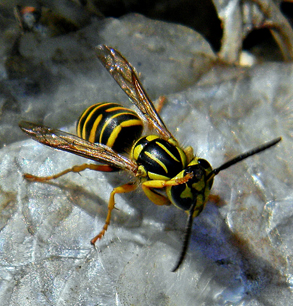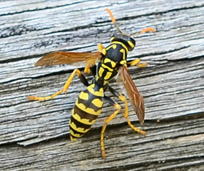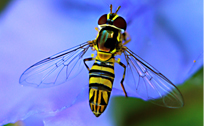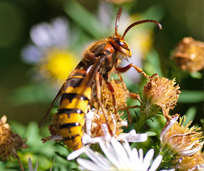Yellowjackets & HornetsJuly Pest of the Month.

What are Yellowjackets and Hornets & what causes them?
Yellowjackets and hornets are the common name in North Central Florida for what most people know as "wasps," which are stinging insects. Both of their colors are generally black and yellow and some such as the Baldfaced Hornet are black and white. Yellowjackets (photo to left) are often mistaken for bees (which are smaller) and confused with hornets. A lot of our population is allergic to wasp venom which can lead to serious problems and can be lethal. (photo to the left courtesy of: Flickr user Bob in Swamp, Photographer: Bob Peterson)
Both yellowjackets and hornets are very active in July and this time of year. They are also extremely active when young children are out and about playing in the yard. Generally there are a few yellowjackets that stand guard at nest entrances and will attack within 2 - 3 seconds from when they are provoked. Provocation of yellowjackets can just be the smell of someone walking by or an animal scent. Then it will release a pheromone that alarms all other defending wasps and hundreds will begin to attack.
Jump to section: Appearance | Symptoms | Habitat | Treatment | More Information
General Appearance
 There is one major difference between hornets and yellowjackets. The term "hornet" means this pest nests above ground and the term "yellowjacket" means it has subterranean (underground) nests. All hornet and yellowjacket species live in colonies. These colonies can range in size from hundreds of hornets or yellowjackets to thousands which make them a "social insect."
There is one major difference between hornets and yellowjackets. The term "hornet" means this pest nests above ground and the term "yellowjacket" means it has subterranean (underground) nests. All hornet and yellowjacket species live in colonies. These colonies can range in size from hundreds of hornets or yellowjackets to thousands which make them a "social insect."
All yellowjackets have a very strong mouth that is great for building its subterranean nest. A single queen yellowjacket can form a small colony between 10,000 - 25,000 yellowjackets per year. Most yellowjackets have stingers that are twice as long as honey bee stingers. Most southern yellowjackets have multiple queens per colony.
There are three types of yellowjackets in Florida:
- Eastern Yellowjacket, Vespula maculifrons (Buysson)
- Southern Yellowjacket, Vespula squamosa (Drury)
- Baldfaced Hornet, Dolichovespula maculate (Linnaeus)
- The Baldfaced Hornet is really a Yellowjacket.
General Facts about Florida Yellowjackets and Hornets:
- Southern yellowjackets are the species most often found in Florida.
- Hornets are generally larger in size than yellowjackets.
- Hornets like to "hang" around in trees.
- The Baldfaced Hornet gets its name from its mainly black color and mainly white face.
- Even though most yellowjackets have subterranean nests they can still nest aboveground and often you can spot their entrance hole into their underground nest.
- Yellowjackets and hornets are attracted to sugar sources such as berries, flower nectars and near the home can be found around soda cans, sweet foods, children, ripe fruit and watermelons.
Also listen to recorded radio interviews with Roy Crain Jr. discussing this month's pest.
Symptoms
 The most apparent sign of a problem is the number of wasps flying around. If you see a few of them heading in the same direction this normally indicates a nest; at this time it's time to call a professional wasp removal company such as Live Oak Pest Control.
The most apparent sign of a problem is the number of wasps flying around. If you see a few of them heading in the same direction this normally indicates a nest; at this time it's time to call a professional wasp removal company such as Live Oak Pest Control.
- There's a hornet nest present when you can see a constant flow of them coming to and from the nest.
- There could be a nest within 100 feet of any wasp you see.
- More than likely if you've spotted a nest on the ground it is a yellowjacket nest. because they prefer to nest on the ground or below.
- Hornet nests are generally located within trees and on the limbs of shrubbery.
Habitat
- Yellowjackets primarily build their nest underground at the base of trees or under shrubbery in loose soil.
- Yellowjackets will sometimes build their nests aboveground in hedges, tree branches and in structures such as a house, porch or garage.
- Yellowjacket colonies generally only have one a year here in North Central Florida due to hard freezes in the winter killing nests.
- All types of wasps can be found on properties where food and water sources are found.
- Wasp nests can be found in roof eaves, holes in the ground or in trees and shrubs.
Treatment
 Treatment and removal of any type of wasp included yellowjackets and hornets are very dangerous! Do not ever attempt to remove yellowjackets and hornets yourself. Never treat wasps with gasoline whether there on the ground or in an aerial nest.
Treatment and removal of any type of wasp included yellowjackets and hornets are very dangerous! Do not ever attempt to remove yellowjackets and hornets yourself. Never treat wasps with gasoline whether there on the ground or in an aerial nest.
Always let experts such as Live Oak Pest Control remove yellowjackets and hornets because what appears to be small above ground can actually be extremely large underground. Our specialists wear special suits and veils that protect them from contact of wasps and stings. As our Pest Specialists have seen firsthand, a yellowjacket entry that appears to be the size of a golfball above ground was literally a 4' x 4' nest underground! Yellowjacket nests that appear to be the size of your thumb can actually be the size of a beach ball underground. This is a specialty service and NOT included in our regular services.
Listen to recorded radio interviews with Roy Crain Jr. discussing this month's pest.
More Information
- Yellowjackets and Hornets : University of Florida Entemology and Nematology
- Hornet : National Geographic
- Baldfaced Hornet : Insect Identification
- Yellowjacket : Insect Identification
